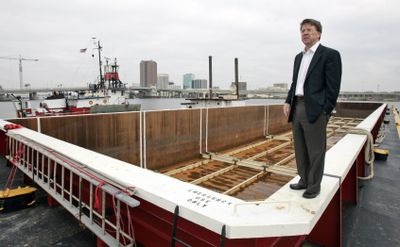Marine shipping gains interest
Climate change, traffic congestion spark second look at once-common practice

NORFOLK, Va. – An idea that dates to Lewis and Clark’s trek west is experiencing a rebirth thanks to the truck traffic that increasingly chokes highways: shift more of the nation’s freight burden to boats that can traverse rivers, lakes, canals and coastal waters.
Increased concerns about fuel prices and global warming in recent years have revived interest in marine highways from the Erie Canal to the Chesapeake Bay to the coastal waters off Oregon, Massachusetts and Texas.
Proponents envision further expansion of the country’s 25,000 miles of navigational waterways by making greater use of the coasts and inland routes, such as the St. Lawrence Seaway, the Great Lakes and the Mississippi and Ohio rivers.
A significant expansion of the marine highway system faces several obstacles:
•Many locks haven’t been updated in decades to accommodate increased freight traffic. Replacing the nation’s lock system would cost an estimated $125 billion.
•A harbor maintenance tax that can add $100 or more on an international cargo container shipped domestically by water. The tax is not collected on cargo moved by trucks or rail, or on U.S. exports.
•The scarcity of U.S. ships to serve domestic ports along short-sea routes. Some blame a federal law that limits shipping between domestic ports to U.S.-built vessels whose crews are at least 75 percent American, a restriction intended to protect U.S. shipbuilders but which critics say has contributed to the industry’s decline by stifling innovation.
Despite these infrastructure and regulatory constraints, entrepreneurs are charting a way forward, one tugboat trip at a time.
Ed Whitmore spent 11 years on Wall Street before returning to his native Virginia six years ago for the rough-and-tumble life of a tugboat operator. He took a “broken down, beat-up company” with one belching tug and expanded Norfolk Tug Co. into a fleet of 10.
With the help of a $2.3 million federal grant, Norfolk Tug has made once-a-week runs up the James River since December 2008, delivering cargo from oceangoing vessels to the Port of Richmond. Each container loaded on a barge removes one truck from the 90-mile stretch along Interstate 64. Whitmore estimates his business removes roughly 4,000 trucks from I-64 each year.
Lawmakers from coastal states and along likely inland routes such as the Mississippi River and the Great Lakes favor short-sea shipping as a means to economic development and job creation.
“In a day and age when we’re trying to save energy and reduce pollution and we’re trying to take some of the clutter off our highways, it just makes sense to do it,” said Rep. Elijah E. Cummings, D-Md.
The rail and trucking industries don’t pay much mind to their much smaller shipping counterpart, though they don’t want to see it grow as a result of public policy. “The market should govern how short-sea shipping is used,” said Clayton W. Boyce, a spokesman for American Trucking Associations.
Before the development of a national rail system and later an interstate highway system, nearly all the country’s goods were shipped on boats. Today, 94 percent of all domestic freight moves on rail or by truck. But not without some cost.
Congestion on roads and rails costs the U.S. economy as much as $200 billion annually and 44 billion person hours, according to the Transportation Department.